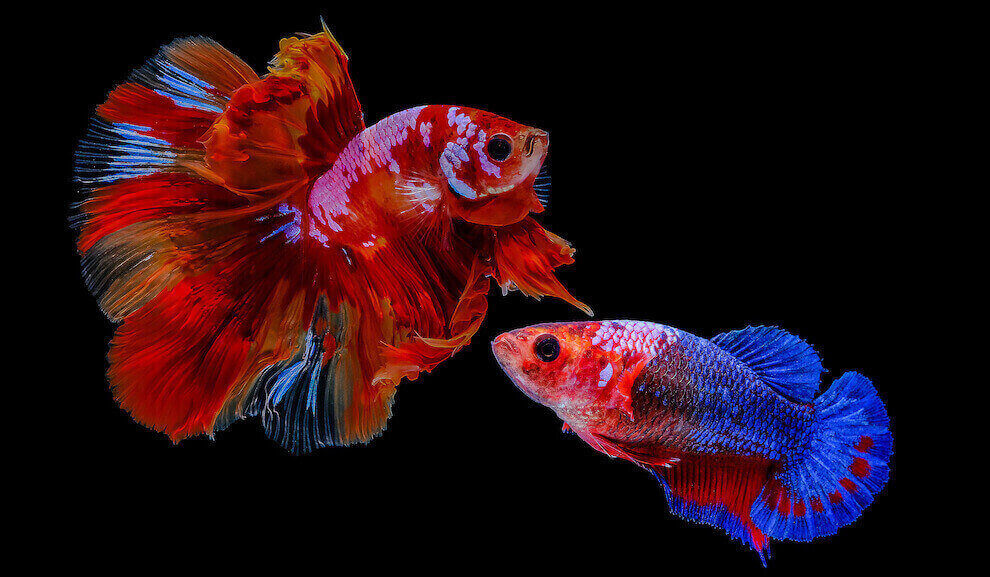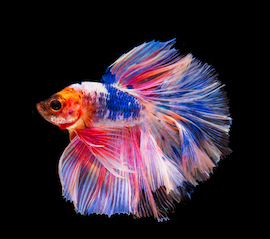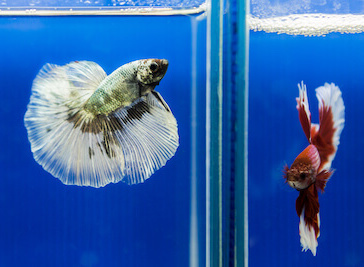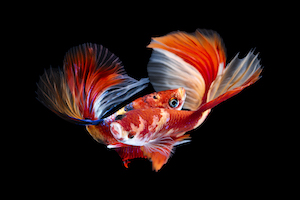
Betta fish have an aggressive character, and they are well known to have flashy colors. Though, they are small among the fish with a massive personality because they come in various shapes and colors. The most dramatic of the betta fish are the males, and they come in a wide range of colors, and they also have gorgeous fins.
Betta fish can be placed both male and female in one large aquarium as they blend peacefully with other fish species. The male betta fish can be kept singly in one aquarium and the females in another aquarium. Still, most people prefer to mix them in one community aquarium as they have an excellent display.
Betta fish come in a wide range of coloring, and you can always get any color you want. The incredible thing about the betta fish is their fins as the males tend to have longer fins than the female betta fish. Though in some circumstances, the males also have the same size of fins as the female ones, which can bring a lot of confusion, especially when it comes to mating the fish pair together.
Setup A Permanent Betta Tank
Setting up a betta fish tank starts with filling two pairs of tanks, both 5 gallons with water, and you must ensure that the water is well cycled in both tanks as you do not want to have a disaster when you bring the betta fish in the tanks. Even though many people prefer placing the fish in one-gallon tanks, that is because of their native Thailand paddy rice fields, which are always shallow. But all in all, it is preferable to place them in 5-gallon tanks for excellent results.
There is still an alternative method of mating betta fish if you do not prefer setting up the gallon tanks. For a long time now, many aquarists have used the oil lamp chimney, and others prefer using the clear plastic cup they use to separate the males from the females. The oil chimney or the plastic cup helps to introduce the males to the females in the tank.
Setting Up a Breeding Betta Tank
The optimum breeding tanks of the betta fish should contain at least 10 gallons of water, and you should always ensure that the tank is in a place that is not near other fish with different colors. The environment should not have an active human activity.
It would help if you introduced plants to the tank as betta fish prefer hiding places in between the plants, and some betta fish also prefer eating the small organisms that grow on the plants. The best plant to always use in the tank is the java fern, as the plant can maintain water quality as it can eradicate toxins from the water tank. If you cannot afford the java fern plant, you can always introduce the plastic plants as they also work well with the betta fish.
The tank also needs to have a heater, which can regulate the water’s temperature. The temperature of the water needs to be around 80 degrees Fahrenheit or 27 degrees Celsius. The filter needs to be adjusted so that it does not disturb the fish in the tank, they do not like to be scared, and they prefer a relaxed environment. The most important thing is to avoid the filter that disturb the bubble nest.
Most people prefer to place something that floats on top of the water surface. You can always use an almond leaf, which many people believe that it produces tannins in the water, which the males use to stop fungal infections from affecting the fish eggs.
The almond leaf is necessary to balance the pH of the water and softens the water inside the tank. It would help if you never introduced rocks or substrate to the fish tank because the fish’ eggs tend to settle on the rocks that are not something right when you do so. So, it is better not to place anything beneath the fish tanks. Only fill the fish tank with 5 to 6 inches of water and ensure that the water is properly cycled that may takes about six weeks.
How to Select A Perfect Pair?
When it comes to selecting a perfect pair, there are some things that you need to consider.
1) Age of the Fish
The ideal age of breeding the betta fry is between the fourth month to the twelfth month. Those are usually the best months to pair the betta fish together for great results. The female betta fish have a more extended breeding period compared to the males. Even though older betta fish can also be paired together and breed well, it is preferred to pair them when they are still young for excellent results.
2) Size of the Fish
When it comes to pairing betta fish, pairing fish of the same size together is preferred. The females should always be slightly smaller than their male counterparts, but never pair a male fish with a large female fish. That is because when it comes to spawning embrace, the male will have a lot of problem wrapping around the larger female. That usually causes frustration to both fish, and in the end, it will also lead to torn fins and tails, and the most dangerous will be that there will be no eggs in the bubble nest.
3) The Health of the Betta Fish

The health of the fish is also important when it comes to pairing betta fish breeding. The fish should be swimming actively, and they should never have torn fins or tails. Their eyes should not be bulging, and the fish should always be free from parasites, and they should have no signs of fungus on them. A healthy fish should not be lying at the bottom of the tank, as that is a sign that it is sluggish.
Condition the Pair
The male and the female fish should always be in separate containers, and some people also believe that the male and the female should not see each other eye to eye. It would help if you only paired them together when it is time to mate.
Your betta breeding fish need to have enough stamina and should be able to avoid any stress that may occur during spawning and courting. That is why conditioning the fish is essential. Conditioning means feeding the breeding betta fish with high-quality foods one or two weeks before spawning. They should eat three to four times a day, and the quantity of food provided to them should also be regulated. When the breeding betta fish have good conditioning, it will always ensure that the females produce many eggs, and the male fish will also have enough energy to spawn the eggs and protect them after mating.
The maximum period of conditioning should be around two weeks, but some highly experienced breeders prefer to condition even longer. The best foods to feed the breeding betta fish during the process are live foods. Live foods are preferred to processed foods as the live foods will shorten the conditioning period. Live foods should include foods like bloodworms, crickets, small insects like live fruit flies, and roaches. Tubifex worms and finely chopped meats can also be good food during conditioning. If you cannot find live foods, you can always use frozen foods like the bloodworms, or even brine shrimps can be a good alternative.
Introduce the Breeding Pair

After the two weeks of conditioning, you are now ready to introduce the breeding betta fish. Many people recommend that you float the fish in a small container with water from the conditioning tank, in the betta fish breeding tank for one hour when presenting the breeding betta. As this will help regulate the water temperature of the water in the tank. After an hour, you can now introduce the male betta fish to the breeding tank. If you have a divider, you will then present the male to the other side of the breeding tank and allow them to swim around.
Before submitting the betta fish breeding pair, you should place them in opposite containers where they can be able to see each other first. You can set the two breeding tanks close to each other so that the males can see the females for a few minutes before pairing them. It always helps to reduce the risk of injuries when you pair them finally.
How Do You Tell If Your Betta Is Ready to Mate?
1) The females usually angle their heads downwards in a submissive manner.
2) The males will start flaring and displaying their fins, trying to show off to the females.
3) Both the males and the females will turn a deeper shade of color, meaning that they are ready to reproduce.
4) The male betta fish will start building a bubble nest, usually made of saliva, to make the bubble durable. The building of the bubble nest takes 24 hours while the females are watching.
5) Females usually tend to have an elongated vent and grow fat, meaning that they are full of eggs.
6) The females will start displaying vertical mating stripes on her body, which is usually visible but difficult to see on the light-colored females.
Release the Female
When the betta breeding fishes have started showing mating signs, and the male fish has begun building a well-sized bubble fish nest, you can then introduce the female to the male. If you are using a tank with a divider, you can remove the partition and let the female and male swim freely around the tank.
If the female Betta breeding fish do not show any signs that they are ready to mate, you should try the next day again, and if you do not see any signs of mating, it is better to introduce a different female. On the contrary, if the male does not show signs of building a bubble nest for some days, try again later and introduce an extra breeding pair. It is funny that some types of betta fish just do not like breeding with other breeds.
Usually, the female Betta prefers red colored males over their other counterparts, which are blue. That is because the females believe that the red colored males have an excellent immune system, and their ability to forage is also high. The red-colored males tend to have a healthy body system, and their genes are even better than their blue males.
Movement is very crucial when it comes to bettas mating ritual. The males who do not show any activity in the tank or are just stationary only mean they are uninterested. So, the females will automatically switch to the blue males who are moving around. Lethargy among the males could mean that the male has a low immunocompetent gene or has a poor forage.
Once the female Betta is ready and showing signs of pairing, you should let her swim to the nest. If she is pleased with the nest, she will not destroy it. When you realize that the female is destroying the nest, you should introduce another female to the breeding tank. It is more likely that the male will chase the female around the tank. The male will keep on chasing the females away as he tries to rebuild his nest. But always keep an eye on the breeding pair as sometimes the male bettas tend to bully the female ones when chasing them around.
It would help if you also introduced hiding places in the breeding tank to provide females with a place to hide when they pursue them. Keep checking on the bettas regularly to prevent serious injuries.
Mating Process

When the females are ready to mate, they start to dance around in circles against each other, flaring their fins, meaning that they are enticed and prepared to mate. The male and female can often be seen dancing circling each other, and nudging each other’s sides.
Finally, the male wraps one fin around the female Betta, displaying an embrace. He then spins the female upside down and fertilizes her eggs. The male will let go of the female. The female will remain suspended upside down with its belly facing upwards. She will then release eggs, which will be fertilized by the male.
The two-breeding pair will repeat the same dance dozens of times until the female produces all her eggs. The male betta fish will tend to catch the eggs with its mouth-coating them with mucus and placing them in the bubble nest. Some female betta fish always eat the eggs, so it is good to remove the female from the tank to avoid losing all the eggs.
Summary
You can tell when the whole process of spawning is over when you see the male Betta chasing away the female from the bubble nest and will not let her near the nest. Once they are successfully done spawning, and the eggs have begun to hatch, feeding them is an overly critical process.







